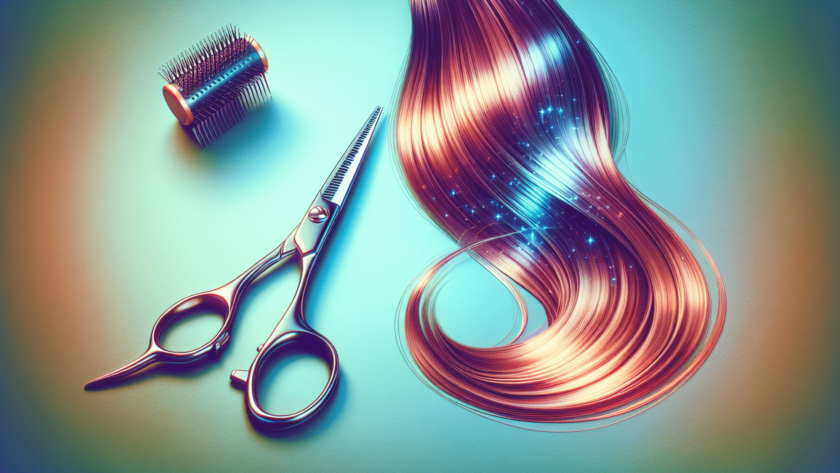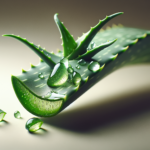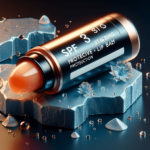Are your hair’s split ends getting in the way of your hair goals? Don’t worry, we’ve got you covered! In this article, you will discover simple yet effective tips on how to prevent split ends and maintain healthy, luscious locks. Whether you have long, short, curly, or straight hair, these tricks will help you bid farewell to those pesky split ends and keep your hair looking its best. From proper haircare routines to lifestyle adjustments, you’ll soon be on your way to saying hello to strong, shiny hair and goodbye to split ends!
Proper Haircare Routine
Maintaining a proper haircare routine is essential for strong, healthy hair. By following a few simple steps, you can significantly improve the overall health and appearance of your hair. Let’s dive into the key elements of a proper haircare routine and explore why each step is important.
Wash your hair less frequently
One of the most common mistakes people make is washing their hair too frequently. Washing your hair every day can strip it of its natural oils, leaving it dry and brittle. Instead, aim to wash your hair 2-3 times a week. This allows your scalp to produce and distribute the natural oils that nourish and protect your hair.
Use a gentle shampoo
When it comes to choosing a shampoo, opt for a gentle, sulfate-free formula. Harsh shampoos can strip away the natural oils and moisture from your hair, resulting in dryness and damage. Look for shampoos that are specifically formulated for your hair type and avoid those containing sulfates, parabens, and other harmful chemicals.
Condition regularly
Conditioning is crucial in maintaining soft, manageable hair. After shampooing, apply a generous amount of conditioner to the ends of your hair and work your way up towards the roots. Allow the conditioner to sit for a few minutes before rinsing it out. Regular conditioning helps to moisturize and nourish your hair, preventing dryness and reducing the risk of split ends.
Avoid hot water for washing
While hot showers may be relaxing, they can be detrimental to your hair. Hot water can strip the natural oils from your hair and scalp, leading to dryness and increased fragility. Instead, opt for lukewarm or cool water when washing your hair. This helps to retain moisture and keep your hair hydrated and healthy.
Avoid Heat Styling
Excessive heat styling can cause significant damage to your hair over time. It’s important to minimize the use of hot tools and adopt heat-free styling methods whenever possible.
Limit the use of hot tools
Heat styling tools such as straighteners, curling irons, and blow dryers can expose your hair to high temperatures, leading to dryness, breakage, and split ends. Try to limit the use of these tools to special occasions or events. Embrace your natural hair texture and opt for heat-free styles on a day-to-day basis.
Apply a heat protectant
If you do need to use heat styling tools, make sure to apply a heat protectant product beforehand. Heat protectants create a barrier between your hair and the hot tool, minimizing the damage caused by heat. Look for heat protectants that contain ingredients such as silicone or keratin to provide added protection and nourishment to your hair.
Air dry your hair whenever possible
Allowing your hair to air dry is the best way to minimize heat damage. Instead of reaching for the blow dryer, gently squeeze out excess water from your hair with a towel and let it dry naturally. If you need to speed up the drying process, use a diffuser attachment on your blow dryer or opt for a low heat setting.
Trim Regularly
Regular trims are crucial for maintaining healthy hair and preventing the development of split ends. Here’s why getting a trim every 6-8 weeks is essential.
Get a trim every 6-8 weeks
Trimming your hair every 6-8 weeks helps to get rid of split ends and prevent them from traveling up the hair shaft. Regular trims also promote hair growth by removing any damaged or weak ends. Consulting a professional hairstylist is recommended, as they can provide personalized advice on the frequency and type of trim your hair needs.
Remove split ends before they worsen
Split ends are prone to splitting further if left untreated. By regularly trimming your hair, you can remove any split ends before they worsen, keeping your hair healthier in the long run. Regular trimming also helps to maintain the overall shape and style of your hair, ensuring it looks its best.
Consult a professional hairstylist
While at-home trimming may seem tempting, it’s best to consult a professional hairstylist for a precise trim. They have the expertise and knowledge to identify and address any hair concerns you may have. A professional trim can make a significant difference in the health and appearance of your hair.
Protective Hairstyles
Protective hairstyles not only look stylish but also help to minimize damage and protect your hair from external stressors. Here’s how to choose and maintain protective hairstyles effectively.
Avoid tight hairstyles
Tight hairstyles, such as tight ponytails, braids, or buns, can pull and strain your hair, leading to breakage and even hair loss. Opt for looser hairstyles that don’t put excessive tension on your hair follicles. This allows your hair to grow and move freely, reducing the risk of damage.
Use hair accessories that minimize tension
When styling your hair, choose accessories such as scrunchies, satin hair ties, or clips that minimize tension on your strands. Avoid using rubber bands or tight elastics, as they can cause breakage and damage to your hair. Gentle accessories help to keep your hair secure without causing unnecessary stress.
Choose hairstyles that reduce friction
Friction can cause damage and breakage, especially when your hair rubs against harsh materials such as cotton pillowcases or clothing. Opt for hairstyles that reduce friction, such as braids, buns, or twists. Additionally, using a silk or satin pillowcase can help to minimize friction while you sleep, keeping your hair protected.
Avoid Chemical Treatments
Chemical treatments such as coloring, perming, or straightening can weaken your hair and make it more prone to damage and split ends. Here’s how to minimize the use of harsh chemicals in your haircare routine.
Minimize the use of harsh chemicals
Reducing your reliance on harsh chemical treatments is key to maintaining healthy hair. While the occasional coloring or styling session may be desired, try to minimize their frequency. Opt for natural alternatives or low-chemical options whenever possible.
Avoid excessive coloring and perming
Excessive coloring or perming can take a toll on your hair’s health. These processes involve harsh chemicals that can weaken your hair’s structure and lead to damage and split ends. If you choose to color or perm your hair, make sure to follow a proper aftercare routine and consult a professional stylist for guidance.
Opt for natural or low-chemical alternatives
When you feel the need for a change in your hair color or texture, consider natural or low-chemical alternatives. There are various natural hair dyes or henna options available that can give you the desired look without exposing your hair to harmful chemicals. Additionally, embracing your natural hair texture eliminates the need for excessive heat styling or chemical treatments.
Proper Brushing Techniques
Brushing your hair may seem simple, but how you do it can make a significant difference in preventing split ends and maintaining the health of your hair. Follow these proper brushing techniques for optimal haircare.
Use a wide-toothed comb or a brush with soft bristles
When choosing a brush or comb, opt for a wide-toothed comb or a brush with soft bristles. These types of brushes are gentler on your hair and help to minimize breakage and damage. Avoid using brushes with rough bristles or combs with fine teeth, as they can cause unnecessary stress on your strands.
Start brushing from the ends, gradually moving upwards
Start brushing your hair from the ends and gradually work your way up towards the roots. This prevents tugging and pulling on your hair, reducing the risk of breakage and split ends. Take your time and be gentle while brushing, especially if your hair is prone to tangling or knotting.
Avoid brushing wet hair forcefully
Wet hair is more delicate and prone to breakage, so it’s important to be gentle when brushing. Avoid forcefully brushing wet hair, as this can cause stretching and breakage. Instead, use a wide-toothed comb or a brush with flexible bristles to detangle your hair gently.
Protect from Environmental Factors
Environmental factors such as extreme weather conditions and chlorinated water can have a negative impact on your hair. Here’s how to protect your hair from these external stressors.
Wear a hat or use a scarf in extreme weather conditions
Extreme weather conditions, such as excessive heat or cold, can cause damage to your hair. Protect your hair by wearing a hat or using a scarf to shield it from harsh sun rays, wind, or cold temperatures. This helps to maintain the moisture level in your hair and prevent dryness and breakage.
Apply products with UV protection
Sun exposure can lead to hair damage, including dryness, color fading, and split ends. Look for hair products specifically formulated with UV protection to shield your hair from harmful sun rays. Applying a leave-in conditioner or a protective spray with SPF can help to minimize sun damage and keep your hair healthy.
Avoid prolonged exposure to chlorinated water
Chlorinated water, whether from swimming pools or certain tap water sources, can strip your hair of its natural oils and cause dryness and damage. Before swimming, wet your hair with clean water to reduce its absorption of chlorinated water. Afterward, rinse and condition your hair thoroughly to remove any traces of chlorine.
Healthy Diet
A well-balanced diet plays a crucial role in maintaining the overall health of your hair. Here’s how to incorporate the right nutrients into your diet for healthier, stronger hair.
Include foods rich in vitamins A, C, and E
Vitamins A, C, and E are essential for healthy hair growth and maintenance. Include foods such as spinach, carrots, sweet potatoes, citrus fruits, berries, avocados, almonds, and sunflower seeds in your diet. These foods are packed with these vitamins and promote healthy hair.
Consume sufficient protein and Omega-3 fatty acids
Protein is the building block of hair, so it’s important to include sufficient amounts in your diet. Foods rich in protein include lean meats, fish, eggs, legumes, and nuts. Additionally, Omega-3 fatty acids, found in fatty fish, flaxseeds, and walnuts, help to nourish the scalp and promote healthy hair growth.
Stay hydrated
Proper hydration is key for maintaining the health and vitality of your hair. Drink an adequate amount of water throughout the day to keep your body and hair hydrated. Water helps to flush out toxins and deliver necessary nutrients to the hair follicles, resulting in stronger, healthier hair.
Avoid Overprocessing
Overprocessing your hair with harsh chemicals and excessive styling products can lead to dryness, damage, and the development of split ends. Here’s how to avoid overprocessing and keep your hair in optimal condition.
Limit the use of hair dyes and bleaching agents
Hair dyes and bleaching agents can cause significant damage to your hair if used excessively. Limit the frequency of coloring or bleaching your hair, allowing your hair to recover and maintain its natural strength. Additionally, choose hair dyes or bleaching agents that are gentle and formulate to minimize damage.
Avoid excessive use of styling products
Using an excessive amount of styling products such as gels, hairsprays, or mousses can weigh down your hair and lead to product buildup. This buildup can suffocate your hair, making it dull and prone to breakage. Use styling products in moderation and choose lightweight, nourishing options that won’t suffocate your hair.
Take breaks from chemical treatments
Whether it’s perming, relaxing, or keratin treatments, taking breaks from chemical treatments helps to minimize damage and give your hair a chance to recover. Embrace your natural hair texture and give it time to breathe between treatments. Regular deep conditioning treatments can also help to restore moisture and repair any damage caused by the chemicals.
Use Hair Masks and Oils
Hair masks and oils can provide an extra boost of nourishment and hydration to your hair. Incorporate these treatments into your haircare routine for healthier, shinier hair.
Apply nourishing hair masks regularly
Hair masks are intensive treatments that deeply condition and nourish your hair. Apply a hair mask once a week or as needed, focusing on the ends of your hair. Look for masks that contain ingredients such as argan oil, shea butter, or coconut oil, which provide hydration and repair damaged hair.
Use oils like argan oil or coconut oil as a leave-in treatment
Oils such as argan oil or coconut oil can be used as a leave-in treatment to provide extra moisture and protection to your hair. After washing and towel-drying your hair, apply a small amount of oil to the ends, avoiding the scalp. These oils help to seal in moisture, reduce frizz, and protect your hair from external damage.
Focus on the ends while applying masks and oils
When applying hair masks or oils, focus on the ends of your hair, as they tend to be drier and more prone to split ends. Gently work the product into the ends and gradually move upward, without applying excessive product to the roots. This ensures that your hair receives the most nourishment where it is needed the most.
By incorporating these tips into your haircare routine, you can effectively prevent split ends and maintain healthy, beautiful hair. Remember, consistency is key. Treat your hair with care, nourish it from the inside out, and enjoy the benefits of a proper haircare routine.




